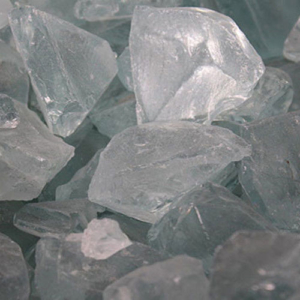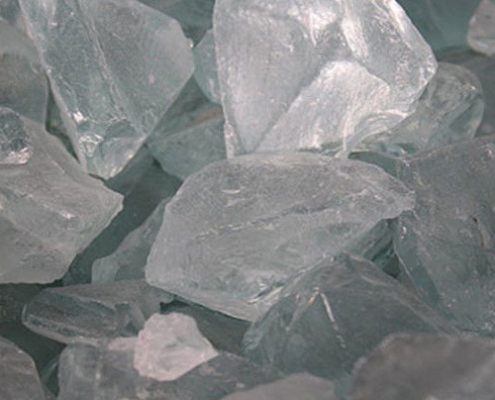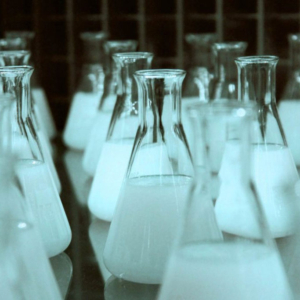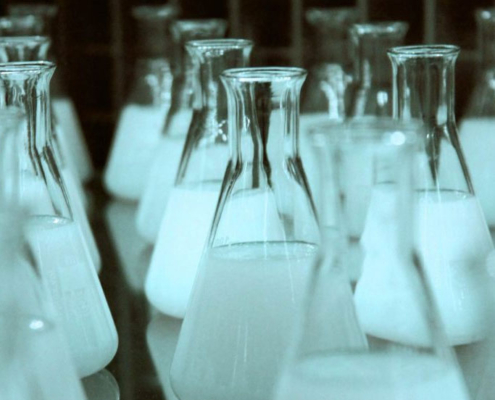Features
The name Sodium Silicate is not specific for a single type of chemical, but with this term it indicates a set of sodium salts of silicic acid very different from each other for behavior and physic-chemical characterization, since the degree of polymerization varies significantly with different parameters.
Their important characteristic is the water solubility, in fact Sodium Silicates are mainly marketed in liquid form. Due to this characteristic solubility and the glassy nature of the solid, sodium silicate in watery solution is commonly called “liquid glass”.
Other important aspects of Sodium Silicate are:
heat resistance, due to the inorganic nature and especially to the non-volatility of silicates;
acid resistance, due to insolubility and the perfect chemical inertia of SiO2 in an acidic environment, except for hydrofluoric acid.
Sodium Silicate’s components are therefore:
silica, SiO2, which is the acidic part of silica
Na2o sodium oxide, which is the basic part of it, water, H2O
The ratio between the amount of silica (SiO2) and alkali (Na2O) present in watery solution defines the characteristics and behavior of the product, since high weighting ratios exhibits a high polymerization and, on the other hand, low weighting ratios presents the monomer forms to a greater extent.
The relationship between these species and their concentration depends not only on the final characteristics, such as viscosity, boiling temperature and density, but also on the classification of the product’s danger and its field of use.
Sodium Silicate is an exclusively inorganic product.
Types
Watery solutions with SiO2/Na2O weight ratio is between 1,6 and 4,0 and may be prepared at different concentrations depending on end-use.
It is also possible to formulate such watery solutions with the addition of specific additives in order to improve their performance in certain areas.
Depending on the application or any specific industrial requirement, our staff is available to define the best type of sodium silicate to adopt.
Packaging
- IBC- 1000 liters polyethylene tanks.
Uses
The particular physico-chemical composition, as well as the ability to polymerize by evaporation of water or by interaction with different media or reagents, make the “liquid glass” very versatile and of fundamental use as an auxiliary for the various industrial and professional sectors.
The main applications of sodium silicate in watery solution are:
- Binding action: by chemical and physical interaction with the substrate, sodium silicate is able to act as an adhesive.
- Buffer action on the pH, keeping it at alkaline values as necessary in applications in detergent or chemical baths of “de-inking” paper industry.
- Film-forming action, due to increased viscosity and the creation of a glass solid film following the evaporation of water.
- Fireproof action, due to the formation of refractory and thermal insulating films that prevent the intimate contact between fuel (wood, paper, cotton, etc.) and oxidizing (air).
- Anticorrosive action on the metals due to both the raising of the pH, and the formation of a single layer of metallic silicate on the surface, which prevents oxidation.
- Flocculant action on cations and polycations.
- Deflocculant and fluidizing action of clay.
- Ion exchange action: silicate is able to reduce the concentrations of calcium, magnesium and metal ions in aqueous solution, thus exerting a softening action against water and inertization of toxic metals.
- Saponificant action.
Due to these properties, Sodium Silicate is used in the following sectors and applications:
- Cleansing.
- Paper industry.
- Construction
- Accelerant for concrete.
- Surface treatment of cement works, such as: industrial floors, docks, dams.
- Soil consolidation by chemical injections.
- Aqueducts, to avoid corrosion of pipes and the consequent pollution of drinking water.
- Ceramic industry, as a deflocculant additive for barbottine.
- Foundries, for the production of molds.
- Paper-making technique, such as adhesive or impregnating paper and board.
- Oil recovery from depleted wells.
- Production of geopolymers.
The list is not exhaustive and the search for new applications, as well as improving those known, is constantly evolving!







